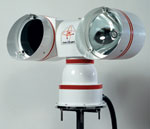Detecting an oil spill at sea can be difficult even in broad daylight. In darkness and under severe weather conditions, it can be an almost impossible task. A black patch of oil on dark water is very difficult to see, even when illuminated by a searchlight from a boat or helicopter. Over the years, oil companies, as well as the coast guard have tested a whole range of methods for detecting oil spills at night: IR radiation, radar, lasers and several types of night-vision systems. These methods are both expensive and complex, while consistently failing to provide a satisfactory solution. Now, however, there is good reason to believe that ultraviolet (UV) light can solve the problem. A radically innovative type of searchlight, easily installed on boats, aircraft or on land, offers a highly effective tool for oil-spill detection. The searchlight’s special-frequency ultraviolet light – sometimes called a "black light" – cuts through darkness, fog, rain and snow. Oil spills that were previously impossible to detect can now be discovered at an early stage, thus offering greater environmental and financial benefits. UV Technology. As is so often the case, the secret behind this technological breakthrough derives from a simple fact: Oil is fluorescent. In darkness, when UV light is directed at an oil film on water, the oil fluoresces in bright colors. The fluorescent properties of oil have long been common knowledge in scientific circles, although few, if any, have previously made the connection with oil-spill detection. Fluorescence occurs when certain materials or substances are irradiated by a short-wave light source. The illuminated object retains the short-wave radiation for some millionths of a second, after which it is reflected as visible, longer-wavelength light. The reflected light can appear as violet, blue, green or any other color in the visible spectrum.
A new UV searchlight for oil detection. During the past few years, ColorLight, a Swedish company, has collaborated on product development with Göran Manneberg, Assistant Professor at The Royal Institute of Technology (KTH) in Stockholm. This effort has resulted in an offering of products and technologies virtually unique to the market. Today, a large number of the company’s dual-headed halogen and UV searchlights are in service as an aid to rescue and navigation efforts for various coast guard, harbor-pilot and air/sea rescue agencies around the world. The searchlights can be independently focused via a patented parabolic reflector with myriad angled steps, similar to a Fresnel lens. A key feature of the searchlight assembly is unlimited rotational movement of each light, independent of each other. The searchlight is fitted with dual slip-ring assemblies, uniquely allowing full and continuous rotation through 360° in both vertical and horizontal planes. It can be remotely operated by a simple joystick control or wireless remote. In addition, it features a heavy stainless steel housing for durability and is IP 66 approved for heavy seas. While application-specific evaluations continue in this field, the unique UV technology offers promising results in oil spill detection. Rickard Sandgren, who heads the Fire & Security Department at Scanraff, one of Northern Europe’s largest oil refineries said, "This could well be the technical solution we have sought for more than 15 years. Tests have shown that the UV searchlight can detect an oil spill in total darkness. We intend to purchase our own UV searchlight and test it on the Swedish west coast." |
||||||||||||||
- Advancing offshore decarbonization through electrification of FPSOs (March 2024)
- Subsea technology- Corrosion monitoring: From failure to success (February 2024)
- Driving MPD adoption with performance-enhancing technologies (January 2024)
- Digital transformation: A breakthrough year for digitalization in the offshore sector (January 2024)
- Offshore technology: Platform design: Is the next generation of offshore platforms changing offshore energy? (December 2023)
- 2024: A policy crossroads for American offshore energy (December 2023)




